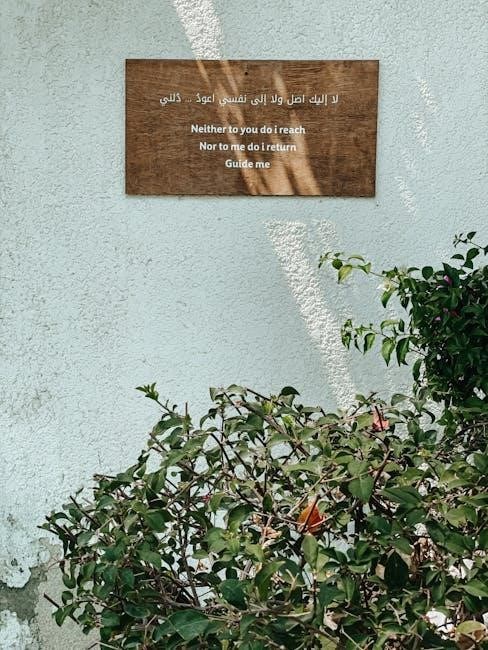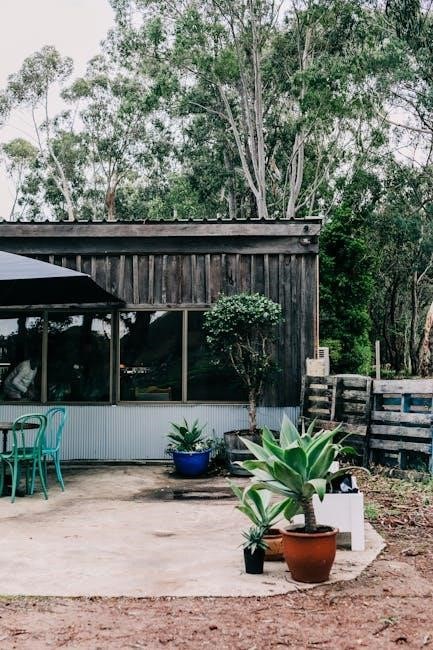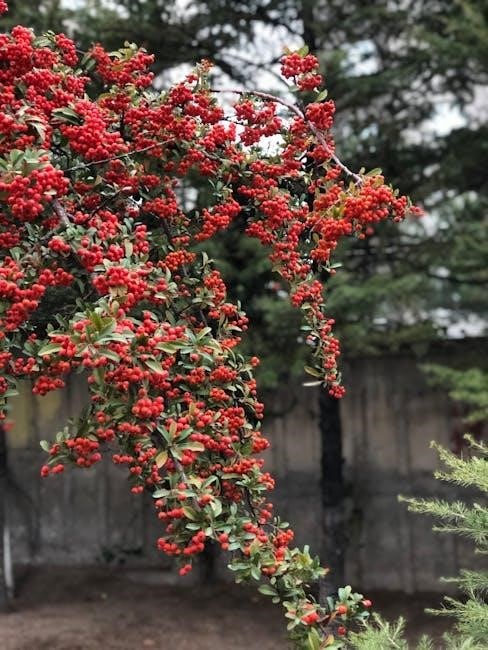Zone 7 offers a moderate climate with a growing season of about 210 days. The last frost date is typically April 15th‚ and the first frost occurs around November 15th. This allows for planting cool-season crops like broccoli and spinach in early spring and warm-season crops like tomatoes and peppers in late spring. Using a Zone 7 planting chart or app can help gardeners plan effectively‚ ensuring optimal growth for both vegetables and flowers.
Understanding USDA Hardiness Zone 7

USDA Hardiness Zone 7 is one of the 11 zones established by the U.S. Department of Agriculture to guide gardeners and farmers on plant hardiness. Zone 7 is characterized by an average annual extreme minimum temperature of 0°F to 10°F (-17.8°C to -12.2°C). This zone typically includes regions with moderate winters and warm summers‚ making it suitable for a wide variety of plants. Areas in Zone 7 experience frost‚ but the growing season is long enough to support both cool-season and warm-season crops. The zone is further divided into two subzones: 7a and 7b‚ with 7a being slightly cooler than 7b. Understanding your specific subzone helps in selecting plants that can thrive in your local climate. This zoning system is essential for determining which plants can survive the winter and when to plant or harvest crops effectively.
Cool-Season vs. Warm-Season Crops in Zone 7
Cool-season crops thrive in Zone 7’s cooler spring and fall temperatures‚ making them ideal for early planting. Vegetables like broccoli‚ spinach‚ kale‚ carrots‚ and radishes perform best when soil temperatures are between 35°F and 70°F. These crops can tolerate light frosts and should be planted in late winter to early spring‚ about 4-6 weeks before the last frost date. Cool-season crops also benefit from a second planting in late summer for a fall harvest. On the other hand‚ warm-season crops require higher temperatures and cannot tolerate frost. These include tomatoes‚ peppers‚ zucchini‚ and cucumbers‚ which should be planted after the last frost date when soil has warmed up. In Zone 7‚ this is typically late April to early May. Warm-season crops thrive during the summer months and are harvested before the first frost in fall. Understanding the distinction between these two categories helps gardeners optimize their planting schedule and maximize yields throughout the growing season.

Key Frost Dates for Zone 7

In Zone 7‚ the last frost date is typically around April 15th‚ while the first frost date occurs approximately November 15th. These dates are critical for determining when to plant warm-season and cool-season crops. Cool-season crops‚ such as spinach and broccoli‚ can be planted outdoors as early as late winter‚ about 4-6 weeks before the last frost date. Warm-season crops‚ like tomatoes and peppers‚ should be planted after the soil has warmed and the threat of frost has passed‚ usually in late April or early May. The first frost date in fall marks the end of the warm-season crop growing period‚ while cool-season crops can be planted again in late summer for a fall harvest. Understanding these frost dates is essential for planning a successful garden in Zone 7‚ as they dictate planting timelines and ensure optimal growth for both spring and fall crops.

Best Vegetables to Plant in Zone 7
Zone 7’s moderate climate supports a wide variety of vegetables‚ making it an ideal location for gardeners. Cool-season crops thrive in spring and fall‚ with broccoli‚ spinach‚ carrots‚ beets‚ and lettuce being excellent choices. These vegetables prefer the cooler temperatures of early spring or late summer and can tolerate light frosts. For warm-season crops‚ tomatoes‚ peppers‚ cucumbers‚ zucchini‚ and squash perform exceptionally well once the soil has warmed. Root vegetables like radishes and turnips also grow quickly and can be harvested in as little as 20-30 days. Leafy greens such as kale and Swiss chard are versatile and can be planted in both spring and fall. Herbs like basil and cilantro also flourish in Zone 7’s climate. With proper planning‚ gardeners can enjoy a bountiful harvest of diverse vegetables throughout the growing season. The long growing season in Zone 7 allows for multiple plantings of many crops‚ maximizing yield and variety in the garden.
When to Plant Vegetables in Zone 7
In Zone 7‚ understanding the optimal planting times for vegetables is crucial for a successful garden. Cool-season crops‚ such as broccoli‚ spinach‚ carrots‚ beets‚ and lettuce‚ thrive in the cooler temperatures of early spring and late summer. These can be planted as early as late winter to early spring‚ with the last frost date typically around April 15th. Planting these in early February allows them to mature before the heat of summer. Additionally‚ many cool-season crops can be planted again in late summer for a fall harvest‚ extending the growing season.
Warm-season crops‚ like tomatoes‚ peppers‚ cucumbers‚ zucchini‚ and squash‚ prefer the heat of summer. These should be planted after the last frost date to avoid damage. Starting seeds indoors 4 to 6 weeks before the last frost date can give tomatoes and peppers a head start. Radishes and turnips have a quick maturity rate of about 20-30 days and can be planted in early spring or late summer. Herbs like basil and cilantro also grow well in Zone 7 and can be planted in the spring after the last frost.
By organizing planting times according to the specific needs of each vegetable‚ gardeners in Zone 7 can enjoy a diverse and productive garden year-round. Planning based on frost dates and the distinction between cool-season and warm-season crops ensures that each vegetable is planted at its optimal time‚ maximizing yield and variety throughout the growing season.
Starting Seeds Indoors for Zone 7
Starting seeds indoors is a great way to get a head start on the growing season in Zone 7. Many vegetables and flowers benefit from being started indoors 4 to 6 weeks before the last frost date. For Zone 7‚ this means beginning seedlings in late February to early March. Tomatoes‚ peppers‚ eggplants‚ and herbs like basil and parsley are excellent candidates for indoor starting. These plants require a longer growing season and thrive when transplanted outside after the soil has warmed up. Additionally‚ starting seeds indoors allows for better control over light‚ temperature‚ and moisture‚ ensuring healthy and robust seedlings. When transplanting‚ choose a cloudy or cooler day to minimize shock. Proper care after transplanting‚ such as watering deeply and providing support if necessary‚ will help the plants transition smoothly. This method ensures that gardeners can enjoy a wide variety of crops throughout the growing season. By planning and starting seeds indoors‚ Zone 7 gardeners can maximize their garden’s potential and extend the growing period effectively.
Planting Herbs in Zone 7
Zone 7 gardeners can enjoy a wide variety of herbs‚ both annuals and perennials‚ by planting at the right time. Cool-season herbs like parsley‚ dill‚ and cilantro thrive in Zone 7’s early spring or late summer‚ while warm-season herbs such as basil‚ mint‚ and rosemary prefer the warmer months after the last frost date. Planting herbs in well-drained soil with full sun ensures optimal growth. For herbs like basil and mint‚ which can be invasive‚ consider using containers to keep them under control. Many herbs benefit from companion planting‚ where they are paired with vegetables or flowers to enhance flavor and deter pests. For example‚ basil pairs well with tomatoes‚ while rosemary complements carrots and peppers. Herbs like chamomile and calendula can also attract pollinators to the garden. Regular pruning and harvesting encourage bushy growth and prevent herbs from flowering. To preserve herbs for year-round use‚ freeze or dry them at the peak of freshness. With proper care and timing‚ Zone 7 gardeners can enjoy a fragrant and productive herb garden throughout the growing season.
Companion Planting in Zone 7
Companion planting is a valuable technique for Zone 7 gardeners to enhance growth‚ deter pests‚ and improve overall garden health. Certain plants‚ when grown together‚ benefit from mutual support‚ such as pest deterrence‚ nutrient sharing‚ or shade provision. For example‚ basil and mint can repel pests that target vegetables like tomatoes and peppers. Marigolds are known to repel nematodes and attract beneficial insects‚ making them a great companion for tomatoes and beans. Similarly‚ nasturtiums deter aphids and whiteflies‚ which can be harmful to cucumbers and squash. Herbs like rosemary and sage can enhance the flavor of nearby vegetables while repelling carrot flies and cabbage moths. Planting radishes alongside cucumbers helps deter cucumber beetles‚ while sunflowers provide shade and support for smaller plants like lettuce. The “Three Sisters” method—planting corn‚ beans‚ and squash together—is another effective companion planting strategy that promotes soil fertility and mutual growth. Remember to avoid planting incompatible species‚ such as members of the Brassica family (broccoli‚ kale) near strawberries or tomatoes‚ as they can hinder growth. By thoughtfully selecting companion plants‚ Zone 7 gardeners can create a balanced and thriving garden ecosystem.
Gardening Tips for Zone 7
Gardening in Zone 7 offers a wide range of opportunities due to its moderate climate and long growing season. To make the most of your garden‚ start by preparing the soil with organic matter like compost or well-rotted manure to improve fertility and drainage. Water management is crucial—ensure plants receive consistent moisture‚ especially during hot summer months. Mulching around plants helps retain soil moisture and suppress weeds. Consider using drip irrigation or soaker hoses for efficient watering. Crop rotation is another key practice to maintain soil health and prevent pests and diseases from building up. Intercropping‚ such as planting leafy greens alongside taller plants‚ maximizes space and reduces soil-borne issues. Keep a gardening journal to track planting dates‚ weather patterns‚ and pest activity for better planning in future seasons. For optimal results‚ use a Zone 7 planting calendar to time sowings and harvests accurately. Lastly‚ always be prepared for unexpected frosts by covering sensitive plants or using cold frames. By following these tips‚ gardeners in Zone 7 can enjoy a productive and thriving garden year-round.
Common Challenges in Zone 7 Gardening
Gardening in Zone 7 comes with its unique set of challenges. One of the most common issues is managing pests‚ such as aphids‚ slugs‚ and squash borers‚ which can damage crops. Diseases like powdery mildew and root rot also pose threats‚ particularly in humid or poorly ventilated conditions. Extreme weather events‚ such as sudden heatwaves in summer or unexpected frosts in spring and fall‚ can stress plants and disrupt growth. Additionally‚ Zone 7’s warm summers often lead to soil drying out quickly‚ requiring careful water management. Weeds can also be problematic‚ competing with plants for nutrients and water. To address these challenges‚ gardeners should adopt strategies like crop rotation‚ companion planting‚ and the use of organic pest control methods. Mulching and drip irrigation can help conserve water and reduce weed growth. Regular monitoring and early intervention are key to preventing infestations and infections. By staying proactive and adaptable‚ gardeners in Zone 7 can overcome these obstacles and enjoy a successful harvest.
Extending the Growing Season in Zone 7
Gardeners in Zone 7 can extend their growing season by implementing a few strategic techniques. One effective method is starting seeds indoors 4-6 weeks before the last frost date‚ allowing plants like tomatoes and peppers to get a head start. Row covers and cold frames can protect crops from early frosts in fall‚ enabling harvests to continue well into October or November. Additionally‚ choosing varieties of vegetables and flowers bred for shorter maturation periods ensures quicker yields. Succession planting is another useful strategy‚ where fast-growing crops like lettuce or radishes are planted in intervals to maximize the growing season. For fall gardens‚ planting cool-season crops like spinach‚ kale‚ and broccoli in late summer ensures a robust harvest before the first frost. Mulching and drip irrigation can also help retain soil moisture and regulate temperature‚ promoting healthy growth. By combining these methods‚ gardeners in Zone 7 can enjoy a longer and more productive growing season‚ making the most of the region’s climate.
Using a Zone 7 Planting Calendar
A Zone 7 planting calendar is an essential tool for gardeners‚ providing a structured schedule for planting‚ sowing‚ and harvesting. These calendars are tailored to Zone 7’s specific frost dates and growing conditions‚ ensuring optimal timing for both cool- and warm-season crops. By following the calendar‚ gardeners can plan when to start seeds indoors‚ transplant them outside‚ and expect harvests. For example‚ cool-season crops like broccoli and spinach are typically planted in early February‚ while warm-season crops such as tomatoes and peppers are started indoors in March or April. The calendar also highlights the best times for direct sowing vegetables like carrots and beans. Many Zone 7 planting calendars include space for notes‚ allowing gardeners to track progress and adjust plans based on weather variations. Digital apps and printable charts are popular options‚ offering reminders and detailed instructions. Using a Zone 7 planting calendar helps maximize yields‚ reduce waste‚ and ensure a successful gardening experience throughout the growing season. It’s a simple yet effective way to stay organized and make the most of the region’s 210-day growing period.




